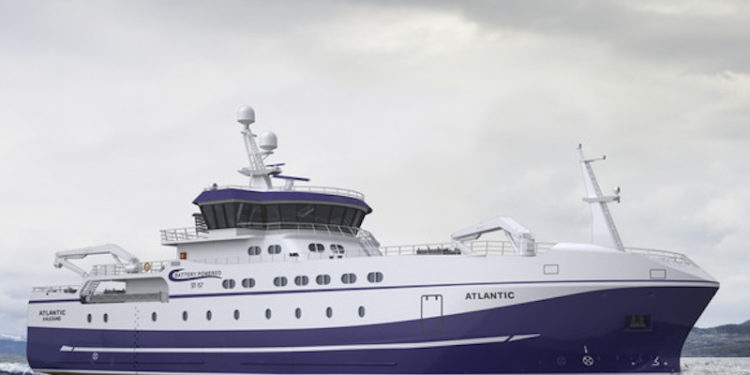A relaxation of the regulations concerning fishing methods, giving operators a freer choice of gear types, has made it possible for Norwegian owners Atlantic Longline to order a new vessel capable of alternating longlining and seine netting. This will be one of the most sophisticated vessels of its kind when delivered in late 2019.
Norwegian naval architect Skipsteknisk has announced a second new longliner contract, only a few days after the announcement of the new Geir to be built at Vaagland Båtbyggeri. This new vessel for Atlantic Longline will be a bigger and more versatile vessel capable of both longlining and seine netting.
The new Atlantic has been ordered from the Tersan shipyard in Turkey with an October 2019 delivery date.
The ST-157 design has an overall length of 62.80 metres and a beam of 14 metres, and Atlantic will feature leading edge energy management technology with battery systems to contribute to fuel efficiency and to optimise the vessel’s emissions footprint. The recovery and optimisation of energy is a theme that runs through the whole of Atlantic’s design.
Operating company Atlantic Longline is based in Ålesund and owned by Jonny Årvik, Kjell-Gunnar Hoddevik and Jan Ove Langeland.
Kjell-Gunnar Hoddevik said that they are taking the shift towards green operation very seriously and the decision by the authorities to relax regulations restricting gear types have made it possible to design this unique vessel capable of switching between seine netting and autolining with a 72,000 hook system.
The factory deck will have a 60 tonnes per day freezing capacity, with possibilities for both fillet and H&G production, with the focus very firmly on maximising quality.
‘We have twenty years of experience of producing high-quality fillets at sea and we intend to continue with this,’ he said, adding that the factory deck will also handle raw material that has been waste in the past.
Atlantic’s processing deck layout incorporates freezing hotels and automatic palletisation, as well as fishroom capacity for 530 tonnes of frozen products on pallets for rapid discharging.
Most of the systems on board will be provided by suppliers locally, including cranes, the autoline system, propulsion and battery systems, freezers and electronics.









